Last-Minute NYC Holiday Gift Guide 🎁
We’ve created a holiday gift guide with presents for the intrepid New Yorker that should arrive just in time—


Stacked high with books old and new and surrounded by iconic dollar carts, the Strand Bookstore at 828 Broadway is the go-to indie bookstore for many New Yorkers, thriving since 1927. Celebrating its 90th anniversary this summer, the Strand is one of the few literary paradises staying strong despite the trend of independent bookstores closing to the likes of Amazon, online booksellers, and e-reading devices.
With over 200 employees and 2.5 million used, new, and rare books, the Strand contains some of the most diverse literary collections in the nation. As a testament to The Strand’s long-standing success, crowds of eager bibliophiles always fill the store, with others intensely browsing for a good deal on the dollar carts. Boasting “18 miles of Books and Counting,” the Strand sells an impressive collection of books new and old, rare works, collectibles, DVDs, CDs, vinyl records, and a vast selection of Strand souvenirs, from Shakespearean socks to political mugs. The Strand is not only successful, but trendy, fitting in with the other hip businesses of the East Village.
During its 90 years, the Strand has accumulated a treasure trove of secrets—secrets about its history, secrets hidden inside its building and operations, and secrets to its enduring survival. Without further ado, and in belated celebration of its 90th anniversary, here are 21 secrets of the Strand bookstore.
If you were to stroll down 4th Avenue between Union Square and Astor Place back when the area was called “Book Row,” the sights and sounds would differ greatly from those of today. While these six blocks are now lined with a variety of restaurants and stores, from the 1890s to 1960s, they were dominated by just one kind of business: secondhand bookstores.
Carts and shops filled with books, catalogues, prints and sketches densely populated the area, making it a bustling haven for bibliophiles and famous writers. These bookstores often specialized in products or genres and only sold secondhand or rare items.
Unfortunately, the passion and integrity of Book Row’s entrepreneurs could not withstand rising rents in the 1950s. New media, the rise of large retail bookstores like Barnes & Noble, and the 1954 closing of the nearby Wanamaker’s Department Store also contributed to a decline in consumers. Many booksellers were forced to close entirely or relocate by the 1960s, with some moving to Broadway.
But there was one exception: the Strand Bookstore, which moved from Fourth Avenue between 10th and 11th Streets, to its current location on the corner of 12th street and Broadway in 1957 and survived.
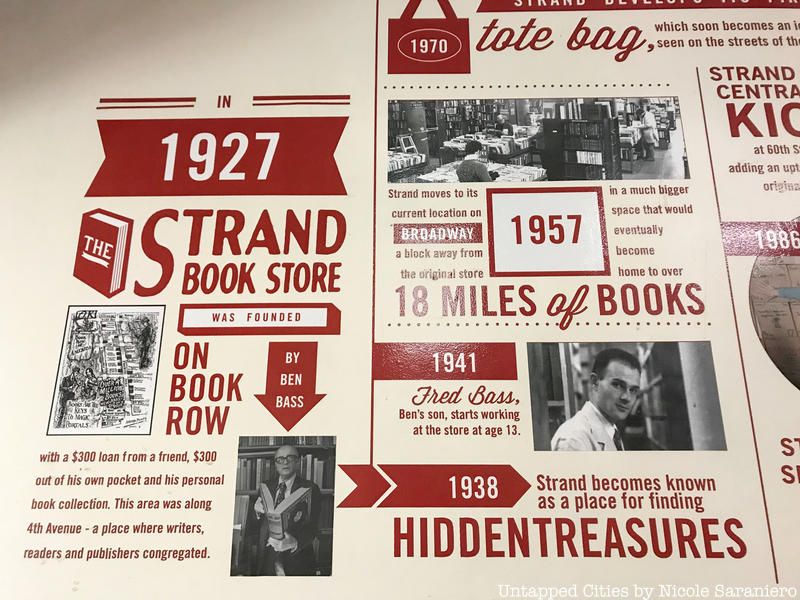
The Strand’s current thriving status was all founded on the hopes and dreams of a 25-year-old man with $600. Both an entrepreneur and bibliophile, the young Benjamin Bass aspired to create a space where books could be loved and fellow bibliophiles could gather to share their love for books. Ben, a Lithuanian immigrant, steadfastly believed in the power of educating oneself through literature, and naturally gravitated to Book Row. Soon enough, he was determined to join it.
After saving up $300 and receiving another $300 loan from a friend, Ben’s visions became a reality. The Strand opened in 1927 and quickly became a go-to bookstore for Greenwich Village bibliophiles, with its popularity rising as Ben expanded the bookstore’s collections. Ben passed away in 1978, but his legacy endures.
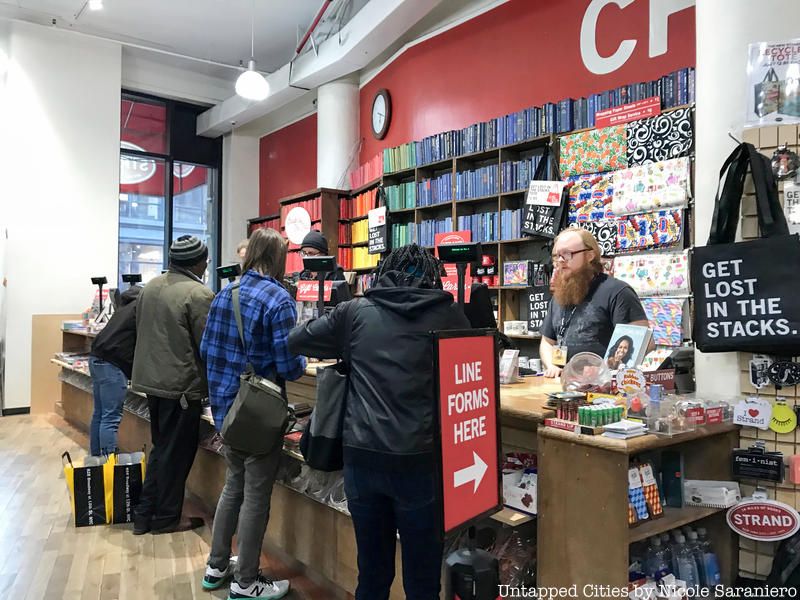
Ben Bass’ son, Fred, began learning the business at the age of 13. Like his father, Fred was a bibliophile and immediately developed an affinity for the book trade. After completing an Armed Forces tour of duty, he returned to New York City to work alongside his father. It was Fred who took the initiative to move the Strand to Broadway in 1957, spending most of his time at the buying desk building relationships with customers.
Next in line was Fred’s daughter Nancy, who started working at the Strand at the age of 25. She now co-runs the store with her father. Her young, modern perspective has brought volumes to the Strand’s business strategy. During her time working at the Strand, Nancy has kept up with the times by spearheading important Strand initiatives, such as the famous Strand tote bag and other merchandise.
Looking ahead, the Strand’s website says, “The jury’s still out on whether one, two or all three of Nancy’s kids will be next in line to join the Strand team.”
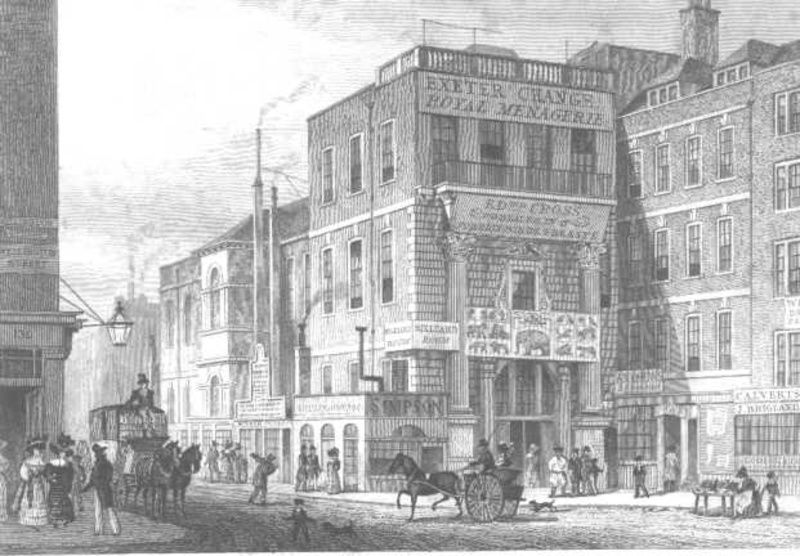
A view of the Exeter Exchange from the Strand in London. Image via Wikimedia Commons
When he opened his bookstore on Fourth Avenue, Ben Bass named it after a publishing street in Central London. In the 18th century, this street was a central hub for the British book trade, filled with with publishing and printing businesses. In London, the Strand was naturally a place where avant-garde writers like George Eliot, William-Makepeace Thackeray, Charles Dickens, and John Stuart Mill gathered. The Strand Magazine, named after this street, was first published in 1891.
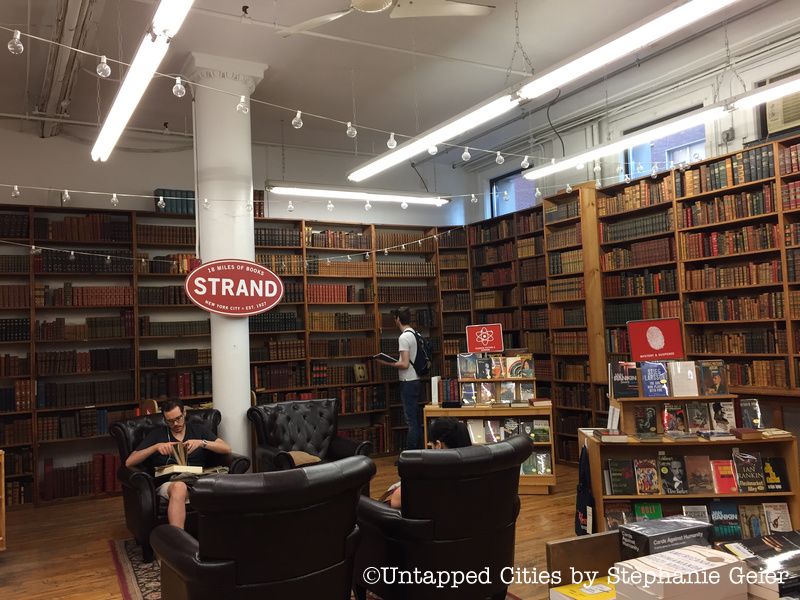
If you’ve visited the Strand but never set foot in its Rare Book Room, then you’re really missing out. The room is only accessible by elevator (not stairs), and is where the Strand hosts its book events. When it’s not hosting events, it makes a wonderfully peaceful reading room with comfy chairs and string lights, giving off the feel of an old, magical attic with its musty book scent that hits as soon as the elevator doors open. The best part of the room, of course, is the tall bookshelves lining the walls filled with ornate, leather-bound books and glass cases showing some of the Strand’s prized rare works. Many of these books are signed editions, with prices ranging from $15 to about $45,000. Whether you’re in the Rare Book Room to attend an event, browse for a rare book, or curl up on a chair and read, it’s always worth exploring and getting lost in.

Given the impact of the Great Depression on many other family-owned businesses in New York City, it’s quite remarkable that the Strand lived through it all. In an interview with The New York Times, Fred Bass said the Strand’s survival of the Depression was key to its current growth.
During the Depression, Ben Bass was falling behind on paying rents. Thankfully, the Strand’s landlord at the time, who was the last heir of Peter Stuyvesant, allowed the store to stay rent-free for a few years until Bass could pay off the debt when the economy improved. In the end, Bass was so grateful to the landlord that he agreed to voluntary rent increases during wartime rent control.
Bass’ trusting relationship with Stuyvesant proved to be valuable once again, when rent control ended and the Stuyvesants doubled the rent for all property in the area—except for the Strand. In 1996, Fred Bass purchased the building, so that the Strand is no longer threatened by the whims of landlords and rising rents.
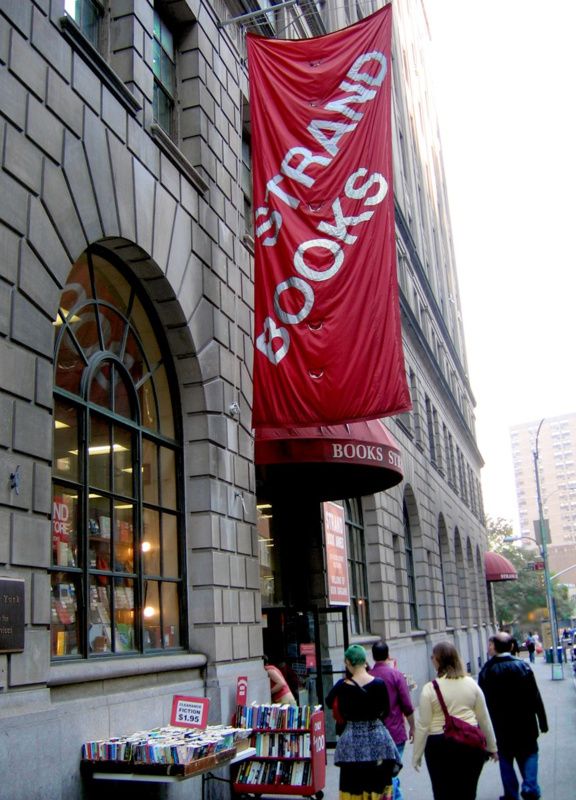
The now closed Fulton Street annex. Image via Wikimedia Commons, Postdlf
Back in the 1980s, the Strand launched a branch in the South Street Seaport area on Front Street. This branch, the “Strand Bookstore annex,” was like the Strand on Broadway and heavily sold used books. But in 1996, it moved from the South Street Seaport area to the Financial District on Fulton and Gold streets. Unlike the Strand today, which is consistently crowded, this branch was a popular spot to visit during lunch breaks and after work. Falling victim to rising rents, the branch closed in September 2008.

Photograph Courtesy of @newyorkdog
The Strand has over 200 employees, but one worker truly stands out from everyone else. Meet Gizmo, the canine employee (sort of) that occasionally makes an appearance at the Strand. As the dog of the Strand’s merchandise director Lisa Jee, she contributes to the Strand’s design team—and must sure be an expert! Gizmo, a nine-year-old maltese-pomeranian-shih tzu mix, is small enough to fit in the stacks, so be on the lookout for her the next time you’re there!
Oh, and follow her on Instagram @newyorkdog.
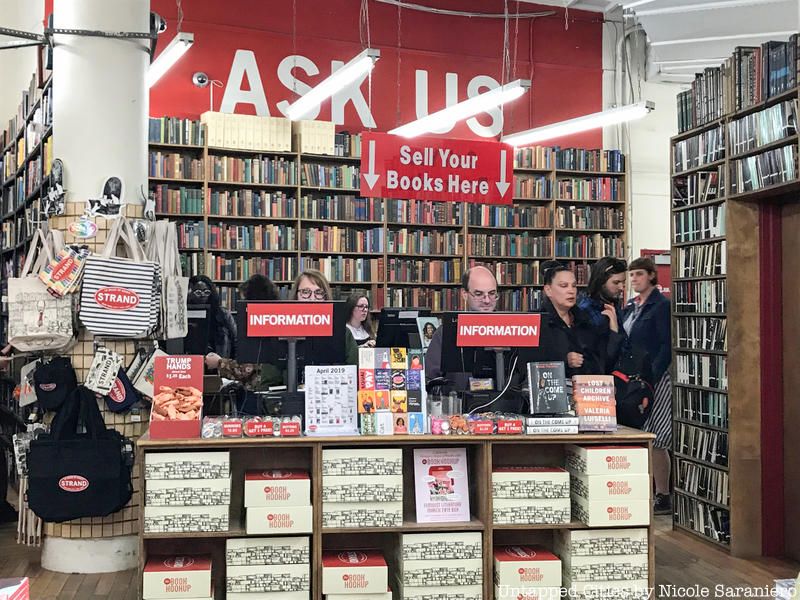

Given Patti Smith’s legacy in New York City, it’s perhaps unsurprising that she found her way to a clerk job at the Strand not long after her career at Scribner’s bookstore, which ended in 1972. What is surprising, however, is that Smith didn’t enjoy her time at the Strand. In an interview with New York Magazine, she explained, “I didn’t like it. I worked in the basement, and it wasn’t very friendly. Scribner’s, though, was beautiful. People there took being book clerks seriously.”
Speaking of famous literary employees, author Mary Gaitskill also worked at the Strand as a clerk during her time, along with poet Thomas Elias Weatherly, Robin Crutchfield, and other literary luminaries.
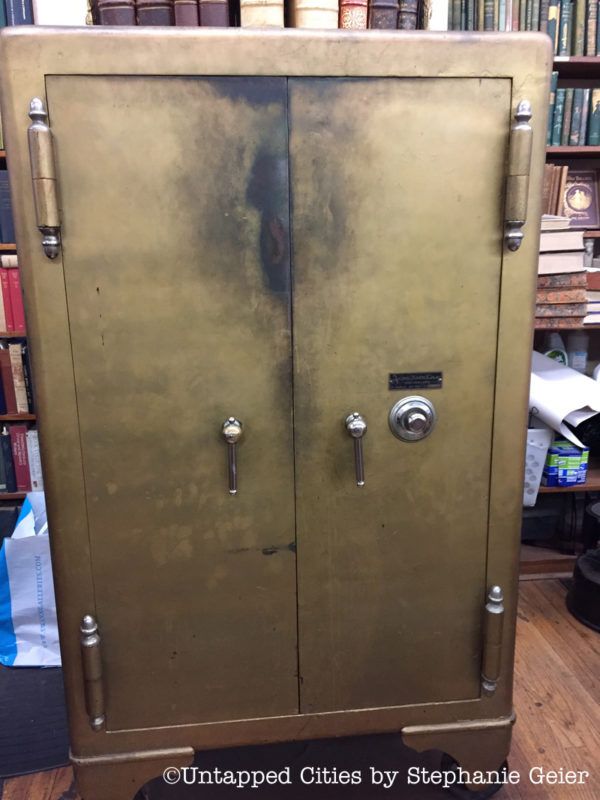
The Strand is packed with rare and precious books, but the cream of the crop is locked away in a safe in the Rare Book Room. The safe contains the Strand’s oldest book, German commentary on the Psalms printed in 1480. It also holds the Strand’s most expensive work, a copy of Ulysses costing $45,000, signed by none other than Henri Matisse, who illustrated this version, and James Joyce himself. If you think this is pricey, know that the most expensive item to ever sell at the Strand was Shakespeare’s first folio for $100,000.

The Central Park kiosk
While it no longer has an annex, the Strand does have a shop at Club Monaco, as well as a Central Park kiosk at 60th street and 5th Avenue, and a Times Square kiosk at 43rd street between Broadway and 7th avenue. The Central Park kiosk is open Monday-Saturday from 10am-dusk and Sundays from 11am-dusk, while the Times Square kiosk is open from 10am-10pm, weather permitting for both.
As we covered in 2013, the process behind the Strand’s Central Park kiosk and this type of city concession is little-known. According to the bookstore’s general manager Eddie Sutton, over the years, the Strand has “had the contract and we’ve not had the contract.” In 2012, it was reported that the city had put out an RFP (Request for Proposals) for the kiosk because the Strand’s 5 year lease was ending on May 1, 2013.
The RFP revealed some fun pieces of information, including:
On a fun note, NYC Parks says the kiosks were created to mimic the book stalls on Paris’ Left Bank.

The Strand offers a multitude of genres, from economics to occult and philosophy. But its fastest growing genre, according to the Strand’s children’s books buyer Stella Williams, in AMNY, is comic books and graphic novels. In 2016, she said sales in this section have tripled over the past few years.
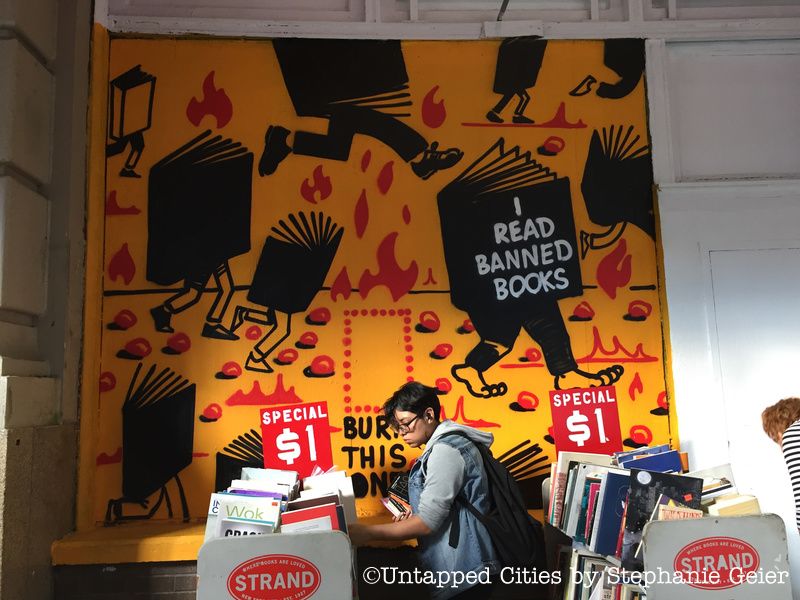
The Strand is a place of character, and its smattering of wall paintings certainly contribute to it in their own spontaneous ways. They adorn certain walls and columns in the store, with the outdoor murals in the backdrop of the dollar carts being the easiest to find. Those hidden in the basement, usually obscured by piles of books or someone reading against the wall, are a little harder to scope out.
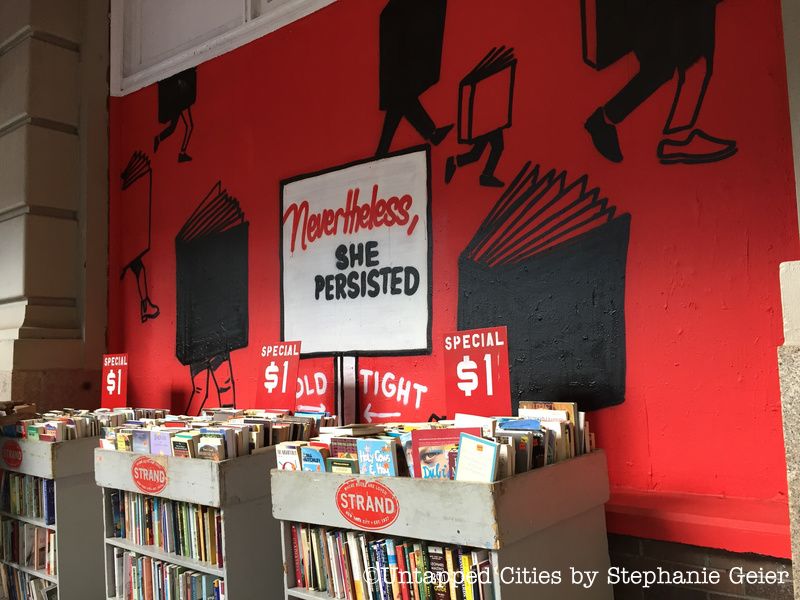
The wall paintings are the creations of none other than renowned New York City artist Steve Powers, more famously known as “ESPO.” He even keeps a painting cart locked away in the store for when he’s ready to create. ESPO is also the man behind some controversial graffiti art, over 50 murals along Philadelphia’s elevated train along Market Street, and New York City’s famous “A Love Letter to Brooklyn,” which was taken down from Macy’s last year. Some of his studio art was also featured at the renowned Venice and Liverpool biennials.
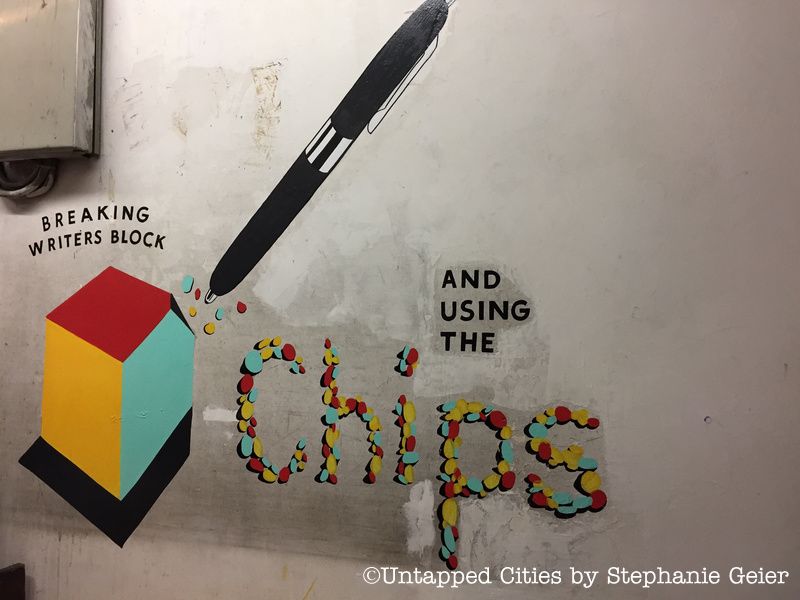

As you browse among books at the Strand, you’ll notice that some have yellow tags near their price stickers, indicating those books are cheaper. This is how the Strand encourages people to buy lesser-known books that don’t quite catch the attention of major literary critics. While determining the bestsellers is out of the Strand’s hands, the staff still does what they can to promote deserving books.

The Strand’s popular readings and events often draw well-known guests to the Strand, and celebrities also like to shop there. Bill Clinton dropped by unannounced in 2015, cast members from Sex and the City were spotted there, and David Bowie was a frequent Strand-goer. Bowie expressed his love for the store, saying, “It’s impossible to find the book you want but you always find the book you didn’t know you wanted.”
Actor Ian Harding also claimed to go there, saying, “I always go to the Strand Book Shop. It’s such a tourist trap, but I always go. I love books—I’m a huge nerd.”
The Strand has hosted several celebrities, both literary and otherwise, during its events, including James Franco, Junot Diaz, David Sedaris, Marina Abramovic, and America Ferrera.
And of course, there was the time when Untapped Cities met Ringo Starr at the Strand to celebrate the publishing of his memoir.
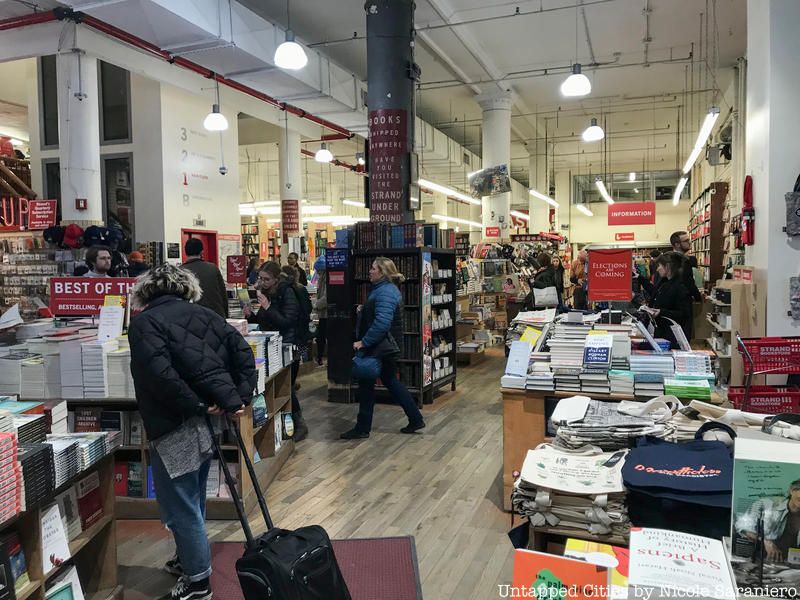
Many iconic areas in New York City make appearances in famous movies, TV shows, and books (check out our lists of New York City film locations for more of that). Given the Strand’s reputation as one of the biggest and best independent bookstores out there, it’s no surprise that filmmakers and writers wanted to include it in their works.
Most prominently, Twilight’s Robert Pattinson played a Strand staff member in the film Remember Me. The Strand even made a name tag for him!
Aziz Ansari also reads in The Strand in the hit Netflix series Master of None, and the store has also made appearances in films like Six Degrees of Separation, Julie & Julia, the miniseries Flesh and Bone, and was referenced in Gilmore Girls. It also appeared in the 1948 movie The Bishop’s Wife.
As for books, the Strand was the setting of Joyce Carol Oates’ short story “Three Girls” and the backdrop for Dash and Lily’s Book of Dares by David Levithan and Rachel Cohn.
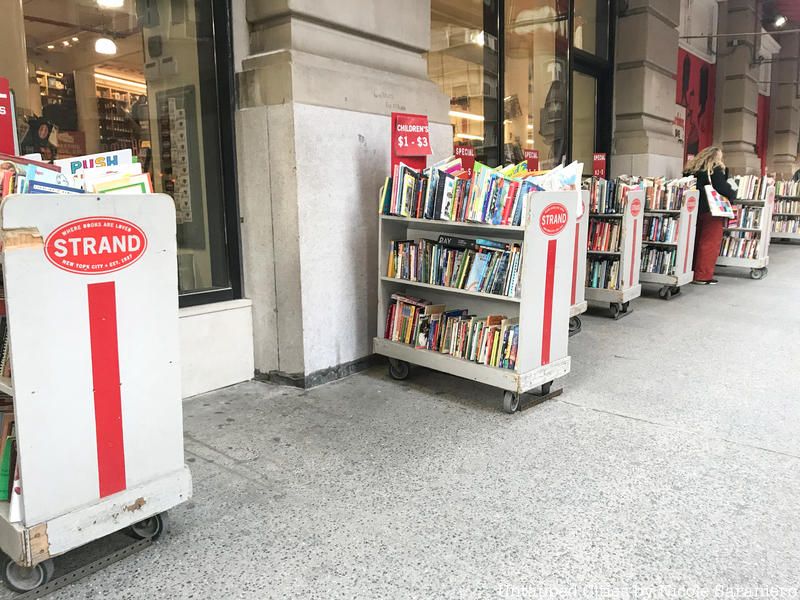
Another testament to the Strand’s thriving growth is its subscription service, called “The Book HookUp.” As the Strand’s first subscription program, the Book HookUp brings subscribers signed, first-edition versions of highly anticipated titles right to their mailboxes, along with other “literary goodies from people and places we love to sweeten the deal.” These mailings are delivered quarterly, with all books hand-picked by the Strand’s expert staff, meaning you can’t choose the books you want delivered. However, the selected books always cover an array of genres and interests, and you can choose from nine different subscription “boxes” to receive, which cover genres from Political Nonfiction to Sci-Fi & Fantasy. In addition to the books, you’ll receive “bonus goodies” from the Strand’s partners, from snacks to literary journals and mugs.
Subscribers receive emails announcing the selected title for the next release, and if you don’t like the subscription book, you can receive store credit for that amount.
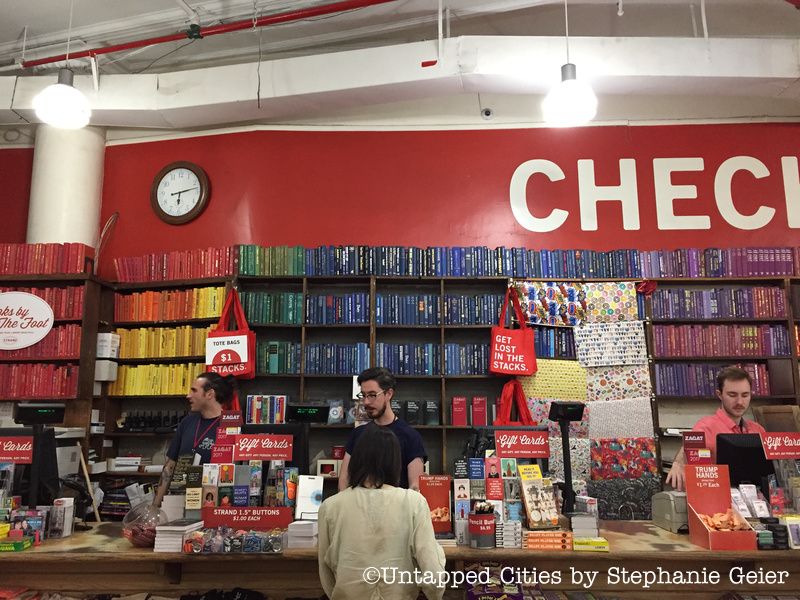
While the bulk of the Strand’s merchandise is selling books, the store also designs custom book collections and rentals for interior decorators, set designers, commercial spaces, and even personal libraries. They’ll work with you to create your dream library, finding everything you need in their 18 miles of books, whether it’s leather bound books or nostalgic childhood reads.
Books by the Foot has three collection options. The first, instant collections, is for people who want to instantly order books in bulk for their personal libraries, allowing you to buy everything from a Markdown paperback collection for $15/ft to an antique leather foreign language collection for $300/ft.
The second, Custom Curation collection, involves expert staff who consult with customers to create their ideal personal libraries, whether you need it for your home, business, or the set of a movie. The staff can travel to and install your collection where you need it for $200/hour per installer.
The third option, rentals, is geared towards creating custom rental libraries to enhance everything from a photo shoot to wedding.
A cool part of the Books by the Foot service is that you can also purchase “books by color,” if, for whatever reason, you need books of a certain hue.
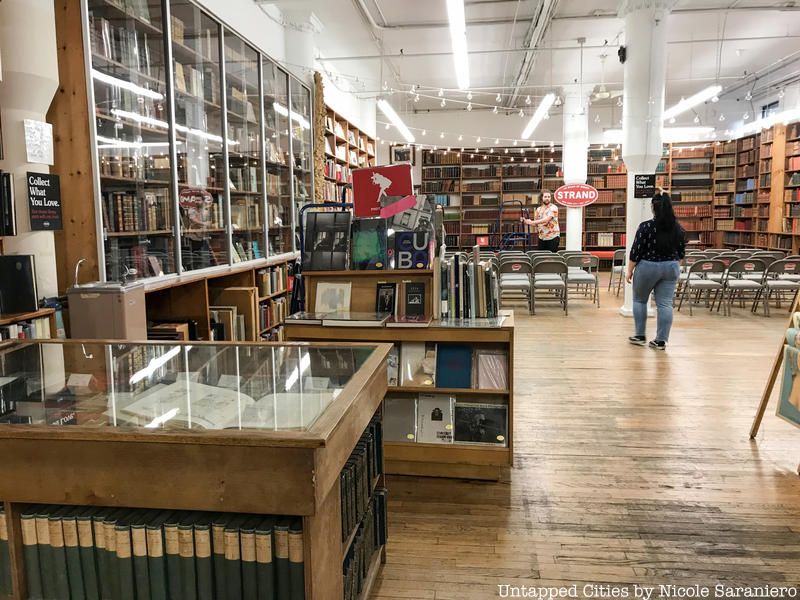
Taking away from the mystique and legendary nature of Strand employees, you might be surprised to know that since the 1970s, they’ve been unionized with United Auto Workers. This has led to management conflict throughout the years, especially when a Strand employee, Greg Farrell, accused Fred and Nancy Bass of proposing “long-term disadvantages to the workers” during 2012 contract negotiations, such as less benefits and personal days and an employee system that they felt would make the union vulnerable.
Angry employees threatened to strike, with both groups eventually reaching an agreement on a contract. However, Farrell continued to contest that the Strand had replaced older, more unionized workers with younger, cheaper ones. He even wrote a graphic novel about the conflict, called On the Books.
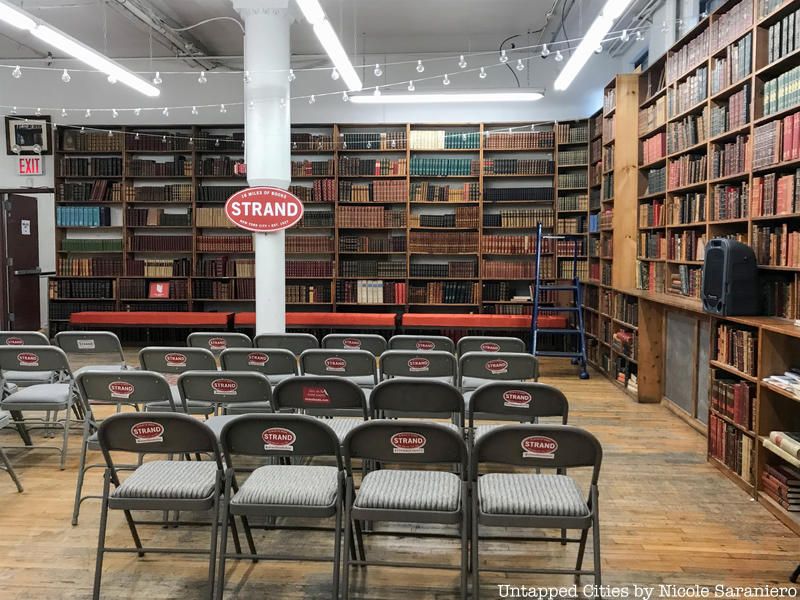
Ever wonder how the Strand’s staff seems to know titles and authors off the top of their heads when you ask a question? Well, the Strand makes sure all applicants are familiar with literature before hiring them through a book quiz, added to the application in the 1970s. According to the New York Times, the ten-line quiz involves matching famous literary works to authors, and is mandatory for not just staff at the main store, but those who work at the kiosks, Books by the Foot, and the Strand’s warehouse in Sunset Park.
About 60 people apply to work at the Strand weekly, but only a couple end up being hired. Fred Bass originally presided over the quiz for about thirty years, but then in 2005, a manager, Carson Moss, took over hiring duties and diversified the quiz, tweaking it every three years to include more females and writers of color. Recently, another manager, Constance Fox, has taken over hiring and overseen the quiz, calling it an “interesting challenge” to choose questions that represent literature’s wide breadth.
In a New York Times article, some staff at the Strand remembered the quiz being relatively easy.
Bass, who would choose diverse major works from Homer to Darwin, said he “once did a sneaky thing” for the quiz: “I made one not match. ‘Gone With the Wind,’ and no Mitchell.”
And yes, applicants have also found ways to be sneaky about the quiz—Bass said that some have found ways to cheat on it, including one man who filled out the application and started asking clerks what the answers were. Another man found the answers with his therapist after swinging by to pick up an application. Both men were hired. Others text friends during the quiz.
Naturally, management doesn’t take the quiz too seriously, according to the New York Times, and it’s based on more of an honors system. However, it’s still a key part of the application. Despite its flawed system, the quiz is one way to stay true to Ben Bass’ vision for it as a place for everyone—including employees—who loves books.
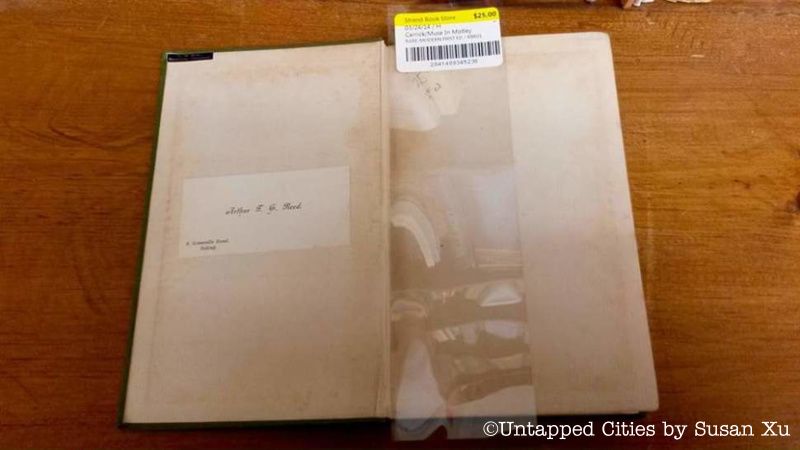
If you buy a used book at the Strand, you might be lucky enough to find an object or note hidden within its pages by the book’s original owner. Over the years, the Strand’s staff has noticed this happening, with a manager telling AMNY, “We used to have buyers here who saved all of it and would hide it behind the books behind the desk, and when we moved our buying desk we found mounds of stuff.”
If you have the time, it’s fun to browse used books at the Strand and see what precious objects and notes they hold, from personal poems to press releases, offering a window into the life of the book’s previous owner.
This article was written with additional help from Untapped Cities writer Laurie Gwen Shapiro.
Next, read 36 of NYC’s Best Independent Specialty Bookstores and 4th Avenue: The History of NYC’s Lost “Book Row”.
Subscribe to our newsletter